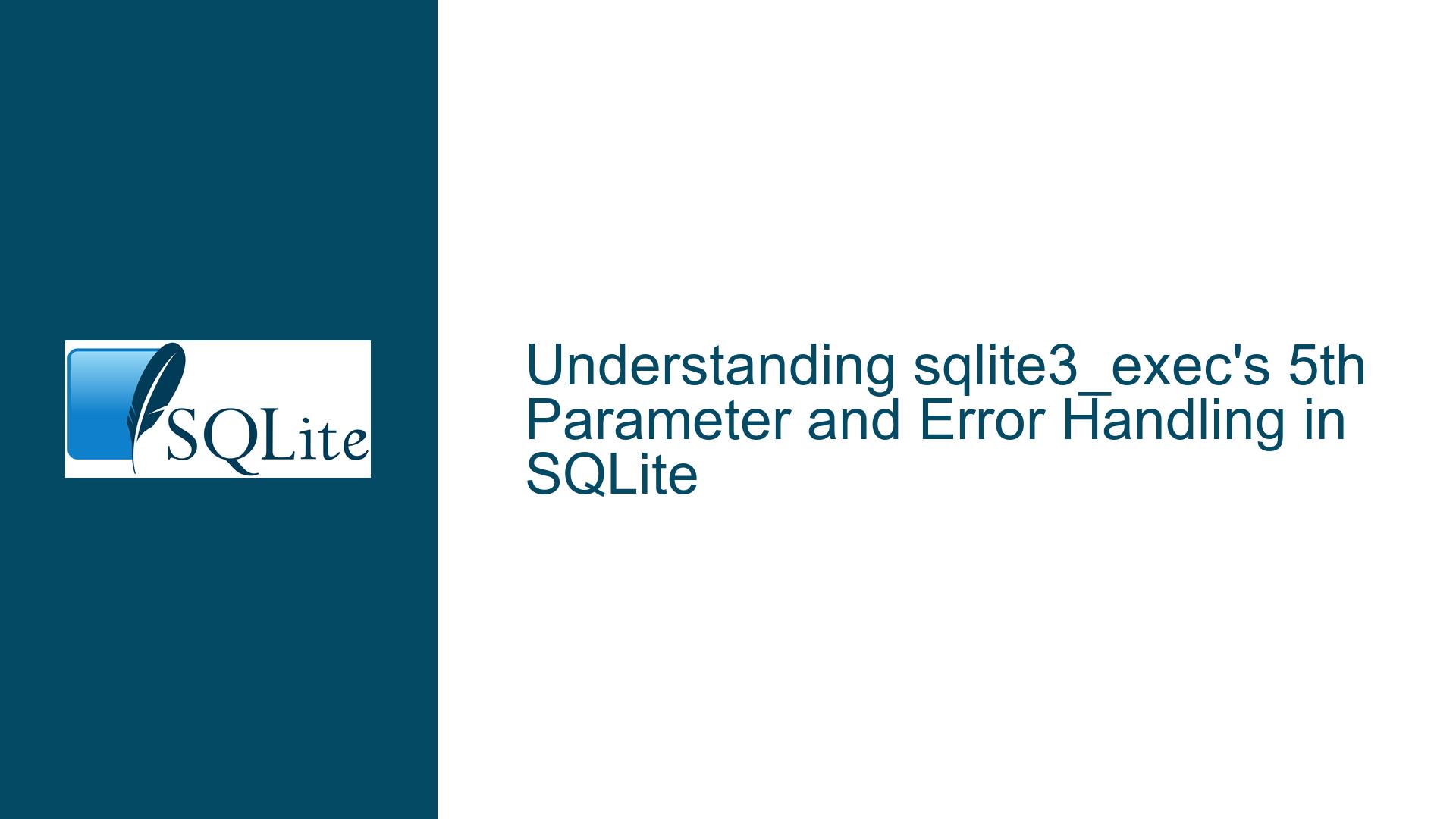sqlite3_exec’s 5th Parameter and Error Handling in SQLite
sqlite3_exec’s 5th Parameter: Error Message Retrieval
The sqlite3_exec function is a widely used convenience function in SQLite that allows developers to execute SQL statements without the need for preparing statements or handling result sets manually. One of the key features of sqlite3_exec is its ability to provide detailed error messages through its 5th parameter. This parameter is a pointer to a string that will contain an error message if the function encounters an issue during execution. However, the usage and interpretation of this parameter can be a source of confusion, especially for developers who are new to SQLite or who are integrating it into higher-level languages like C#.
The 5th parameter of sqlite3_exec is an optional out parameter that can be used to retrieve a verbose description of the error when the function does not return SQLITE_OK. This parameter is particularly useful for debugging and logging purposes, as it provides more context about what went wrong during the execution of the SQL statement. However, it is important to note that this parameter is only set and meaningful when the return code is not SQLITE_OK. In cases where the function returns SQLITE_OK, the 5th parameter will not contain any useful information and should not be relied upon.
Moreover, there are certain scenarios, such as when the function returns SQLITE_NOMEM, where the error message might not be set even though the function did not return SQLITE_OK. This adds another layer of complexity to the error handling process, as developers need to be aware of these edge cases and handle them appropriately.
When to Check the 5th Parameter: Return Code Analysis
The decision of when to check the 5th parameter of sqlite3_exec largely depends on the return code of the function. The return code is an integer that indicates the success or failure of the SQL statement execution. A return code of SQLITE_OK (0) indicates that the operation was successful, and in this case, the 5th parameter will not contain any meaningful error message. Therefore, checking the 5th parameter when the return code is SQLITE_OK is unnecessary and could lead to confusion.
However, when the return code is not SQLITE_OK, the 5th parameter becomes a valuable source of information. In such cases, the 5th parameter will typically contain a detailed error message that can help developers understand what went wrong during the execution of the SQL statement. This is particularly useful for debugging purposes, as it provides more context than the return code alone. For example, if the return code is SQLITE_ERROR, the 5th parameter might contain a message like "no such table: my_table", which clearly indicates the source of the problem.
It is also important to note that the 5th parameter is not guaranteed to be set in all cases where the return code is not SQLITE_OK. As mentioned earlier, in cases where the function returns SQLITE_NOMEM, the error message might not be set. This is because the function might not have enough memory to allocate the error message string. Therefore, developers should always check the return code first and only then consider checking the 5th parameter if the return code indicates an error.
Best Practices for Handling sqlite3_exec Errors
Handling errors in sqlite3_exec requires a careful approach that takes into account both the return code and the 5th parameter. The first step in any error handling routine should be to check the return code. If the return code is SQLITE_OK, the operation was successful, and there is no need to check the 5th parameter. However, if the return code is not SQLITE_OK, the 5th parameter should be checked for a detailed error message.
When checking the 5th parameter, developers should be aware that it might not always be set, even in cases where the return code indicates an error. This is particularly true for return codes like SQLITE_NOMEM, where the function might not have enough memory to allocate the error message string. In such cases, developers should rely on the return code alone to determine the nature of the error.
In addition to checking the return code and the 5th parameter, developers should also consider implementing a robust logging mechanism that captures both the return code and the error message (if available). This can be particularly useful for debugging and monitoring purposes, as it provides a detailed record of what went wrong during the execution of SQL statements.
Another best practice is to use the sqlite3_errmsg function to retrieve the error message associated with the most recent failed SQLite operation. This function can be used as an alternative to the 5th parameter of sqlite3_exec, and it provides a more consistent way of retrieving error messages across different SQLite functions. The sqlite3_errmsg function returns a pointer to a string that contains the error message, and it can be used in conjunction with the return code to provide a more comprehensive error handling routine.
Finally, developers should always ensure that they free any memory allocated for error messages. The 5th parameter of sqlite3_exec points to a string that is allocated by SQLite, and it is the responsibility of the caller to free this memory using sqlite3_free. Failure to do so can result in memory leaks, which can be particularly problematic in long-running applications.
In conclusion, the 5th parameter of sqlite3_exec is a powerful tool for error handling in SQLite, but it requires careful handling to avoid common pitfalls. By following the best practices outlined above, developers can ensure that they are using this parameter effectively and that they are able to handle errors in a robust and consistent manner.






